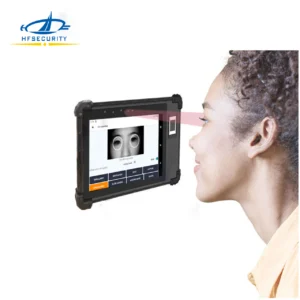What Is Iris Recognition?
Iris recognition is a biometric technology that identifies individuals based on the unique patterns in their iris — the colored part of the eye. Every person’s iris pattern is distinct, even between identical twins, making this method extremely reliable. Iris scanners use infrared light to capture high-resolution images of the iris and then match them against stored templates for verification.
This technology is widely used in government ID programs, border control systems, hospitals, and corporate access control, where accuracy and liveness detection are top priorities. Compared to other biometric methods, iris recognition remains one of the most forgery-resistant solutions available today.
What Is Face Recognition?
Facial recognition technology identifies or verifies a person by analyzing facial features using artificial intelligence (AI) and 3D mapping. The system scans various facial landmarks — such as the eyes, nose, and jawline — to create a digital signature that can be matched against stored data.
Facial recognition is popular for its speed, contactless operation, and user-friendly interface. It is commonly used in smartphones, offices, turnstiles, airports, and attendance systems. With advancements in deep learning and neural networks, modern face recognition systems can achieve high accuracy even in challenging lighting environments.
Accuracy and Security Comparison
When comparing iris scanners vs face recognition, accuracy is the key differentiator.
Iris recognition offers an error rate as low as 1 in 1.5 million, thanks to the unique texture and stability of the iris pattern. Even with aging or minor physical changes, the iris remains consistent throughout a person’s life.
Facial recognition, while improving rapidly, can be affected by lighting conditions, facial expressions, makeup, or masks. False positives or negatives may occur, especially in poor visibility or when image quality is compromised.
In terms of security, iris scanners are more difficult to spoof, as they include liveness detection to ensure that the eye being scanned is real and not a photo or artificial replica. Facial recognition systems are more vulnerable to photo attacks or deepfake manipulation, although newer systems are integrating anti-spoofing algorithms to address this.
User Experience and Convenience
While iris scanners provide unmatched precision, they often require the user to be within a specific range and angle for accurate detection. On the other hand, face recognition is faster and more convenient, enabling users to authenticate from a distance without needing to stop or align precisely with the camera.
This makes facial recognition ideal for high-traffic areas such as offices, schools, and transportation hubs, where fast throughput is important. Meanwhile, iris recognition is more suitable for high-security zones, research labs, or data centers, where identity assurance is critical.
Integration with Access Control and Attendance Systems
Both technologies can be integrated into modern access control and time attendance systems.
Many organizations use HFSECURITY iris scanners or face recognition devices connected with HFIMS attendance software for efficient management. The combination of biometric precision and cloud-based reporting allows for real-time monitoring, employee scheduling, and visitor management.
Additionally, iris scanners can be combined with fingerprint recognition, NFC cards, or QR code verification for multi-factor authentication, ensuring a balance of convenience and maximum protection.
Cost and Maintenance
Facial recognition systems
Facial recognition systems are generally more affordable and easier to deploy since they can work with standard cameras and require minimal user training.
Iris scanners
Iris scanners, however, tend to be more expensive due to their specialized imaging components and processing algorithms. Despite the higher cost, they offer long-term reliability and minimal false matches, making them an excellent investment for critical infrastructure and government projects.
Comparison Table: Iris Scanner vs Face Recognition
| Feature | Iris Scanner | 얼굴 인식 |
|---|---|---|
| Biometric Basis | Uses unique patterns in the iris for identification. | Uses facial features and structure for identification. |
| 정확성 | Extremely high — error rate as low as 1 in 1.5 million. | Moderate to high — affected by lighting, expressions, or masks. |
| Security Level | Very secure; difficult to spoof due to liveness detection. | Secure but vulnerable to photo and deepfake attacks. |
| Speed of Recognition | Slightly slower due to precise alignment. | Very fast and contactless, suitable for high-traffic areas. |
| User Convenience | Requires specific positioning near the scanner. | Highly convenient; works from a distance. |
| Environmental Adaptability | Works well in low light or complete darkness (infrared-based). | Performance may drop under poor lighting or glare. |
| Maintenance Needs | Low maintenance once installed; sensors are durable. | Requires regular calibration for consistent accuracy. |
| 비용 | Higher cost due to advanced optical sensors. | Generally more affordable and easier to deploy. |
| Best Use Scenarios | High-security areas: government offices, data centers, research labs. | Offices, schools, airports, turnstiles, and attendance systems. |
| Integration Options | Can be integrated with fingerprint, NFC, or QR for multi-factor security. | Easily integrated with AI systems, mobile devices, and cloud attendance software. |
| 개인정보 보호 문제 | Minimal — iris data is highly protected and encrypted. | Higher — facial data can be captured in public spaces. |
| Liveness Detection | Built-in infrared detection prevents spoofing. | Available in advanced models with AI algorithms. |
| Long-Term Reliability | Iris pattern remains stable for life, ensuring consistent recognition. | Facial features can change over time (aging, beard, glasses, etc.). |
Which One Should You Choose?
The choice between iris recognition and face recognition depends on your priorities:
Choose iris scanners if your project demands maximum security, high precision, and identity assurance in sensitive environments.
Choose face recognition if your goal is speed, ease of use, and cost efficiency in everyday access control or attendance systems.
For most organizations, a hybrid biometric solution that combines multiple recognition methods — such as iris, face, and fingerprint — provides the best balance of security and usability.
결론
Both iris scanners and face recognition systems represent the future of biometric security. While facial recognition continues to dominate for its convenience and speed, iris scanners remain the gold standard for accuracy and fraud prevention.
As security needs evolve, integrating both technologies with intelligent management software like HFIMS ensures that organizations stay protected, efficient, and future-ready.



